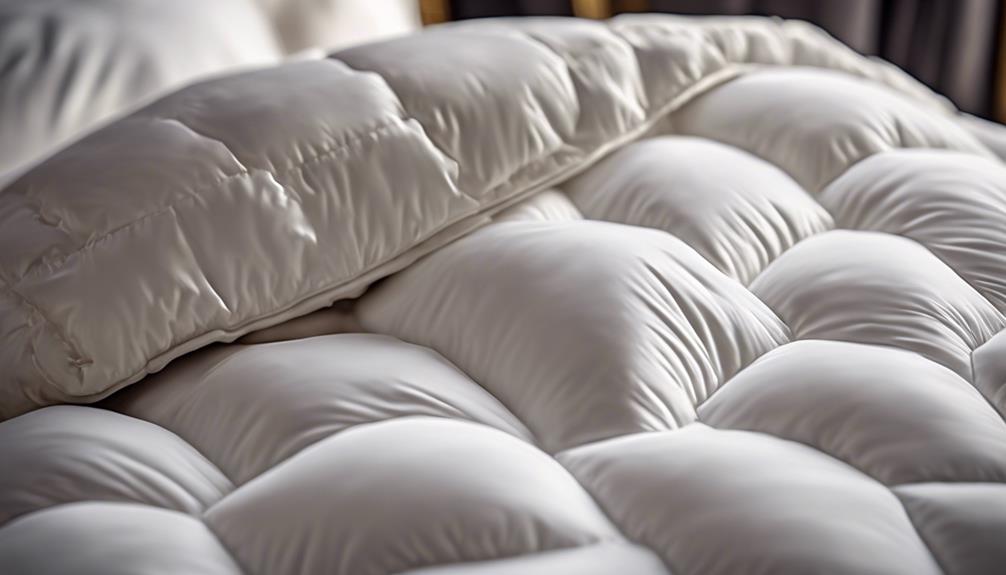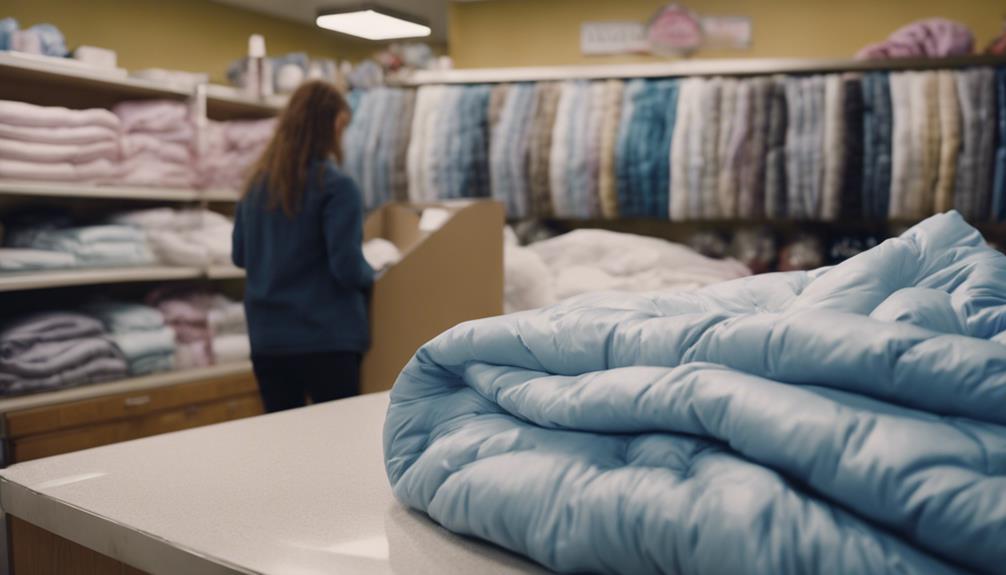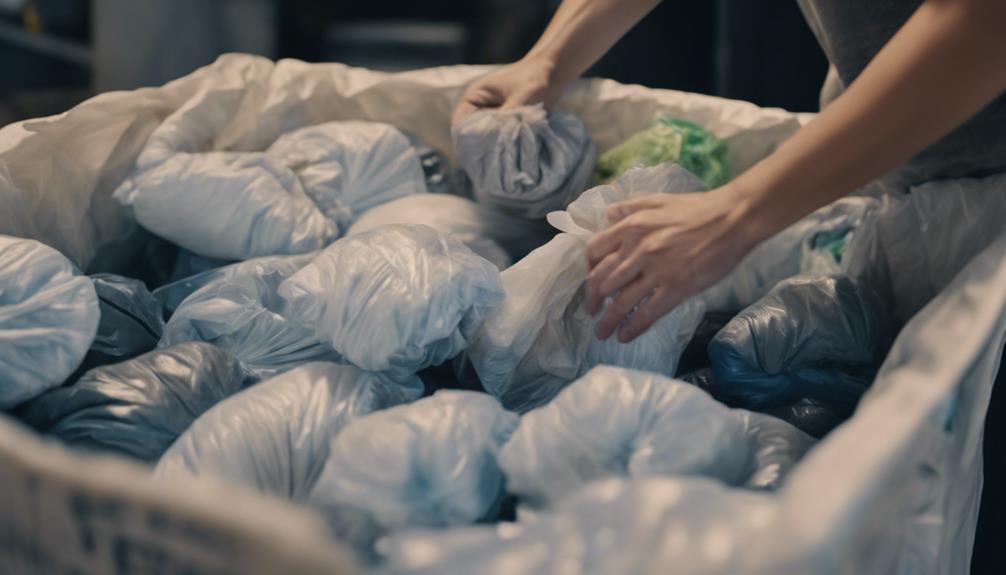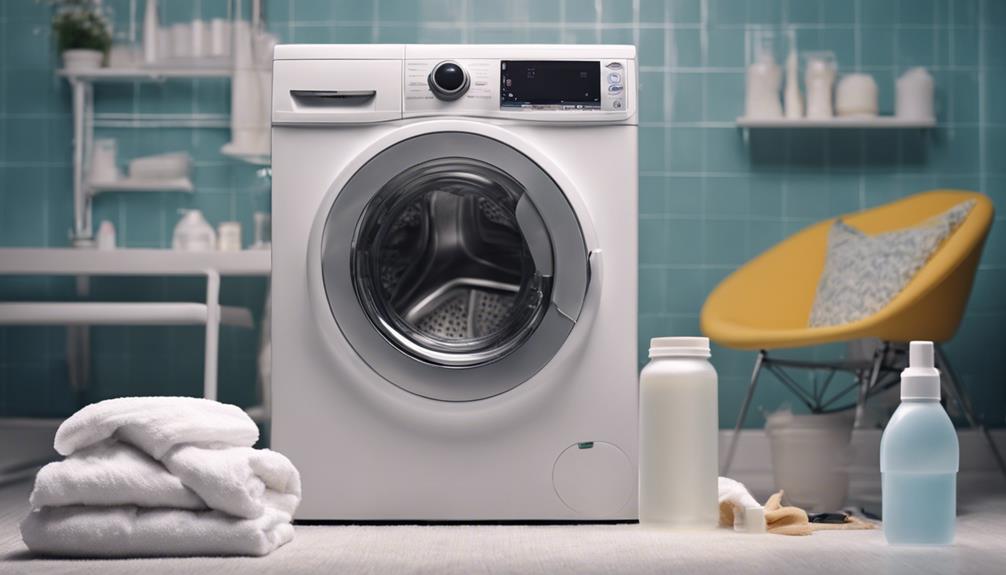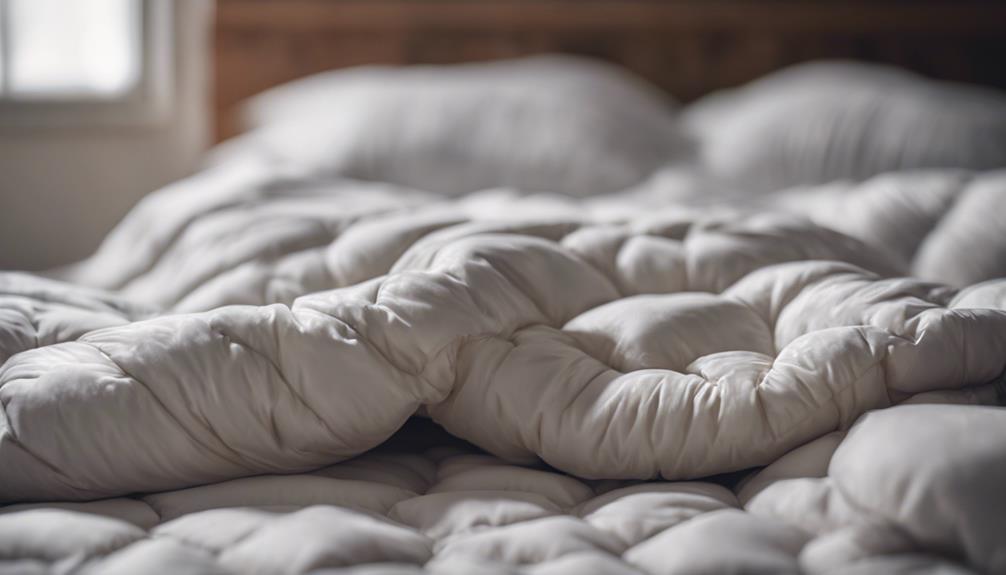A goose down comforter is a luxurious bedding option filled with soft feathers found beneath the outer layers of geese. The down clusters provide exceptional warmth and insulation due to their fill power. Lightweight and breathable, these comforters offer cozy warmth. The natural properties of goose down ensure both durability and comfort. Explore the advantages and different types of goose down comforters to improve your quality of sleep.
Key Takeaways
- Goose Down Comforter is filled with soft feathers beneath geese's outer feathers for luxurious warmth.
- Down clusters provide excellent insulation and loftiness for a cozy and breathable sleep experience.
- Higher fill power signifies better quality and superior warmth retention.
- Known for durability, resilience, and long-lasting quality compared to other types of down.
- Opting for Hungarian white goose down ensures premium comfort and insulation properties.
Definition of Goose Down Comforter
When considering the meaning of a goose down comforter, it's important to understand that it's filled with the soft, fine feathers found beneath the outer feathers of geese. These feathers, known as down clusters, are of exceptional quality, providing the comforter with its luxurious feel and excellent insulation properties.
The fill power of a goose down comforter is a vital factor in determining its quality, with higher fill powers indicating superior warmth and loftiness.
Goose down comforters are renowned for their lightweight nature, breathability, and ability to offer cozy warmth without feeling heavy. Choosing a goose down comforter ensures a bedding option that isn't only high in quality but also durable and resilient.
The natural insulation properties of goose down make these comforters a popular choice for those seeking a comfortable and long-lasting bedding solution. With their combination of softness, warmth, and durability, goose down comforters are a top choice for a restful night's sleep.
Characteristics of Goose Down
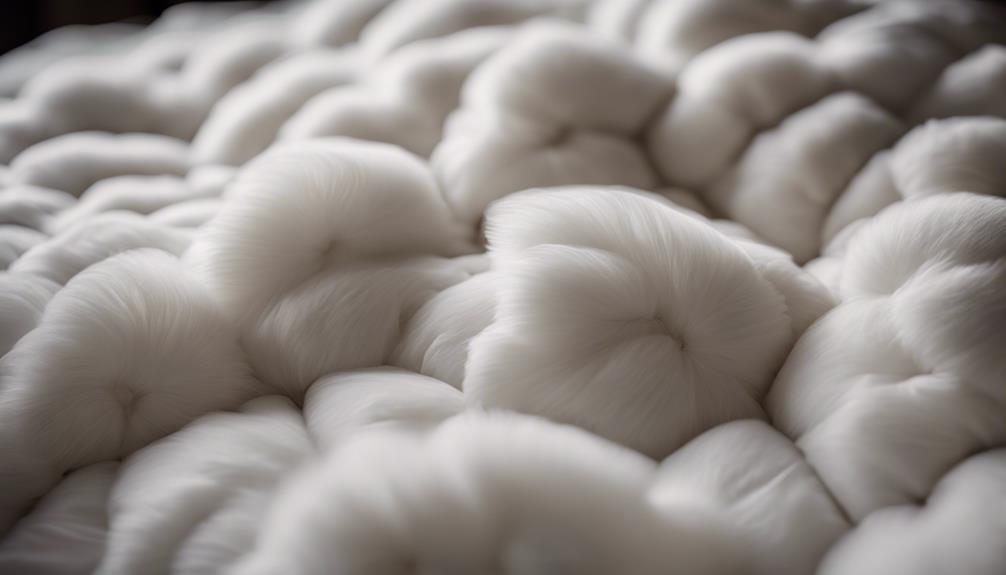
Moving on from the definition of goose down comforters, exploring the characteristics of goose down sheds light on its exceptional insulation and durability. Goose down, the fine feathers found underneath a goose's outer feathers, is known for its higher fill power compared to duck down. Fill power determines the warmth and fluffiness of the comforter, with higher fill power indicating better quality and insulating ability. Goose down clusters are larger and provide superior insulation, making goose down comforters a popular choice for those seeking warmth and comfort.
Additionally, goose down comforters are recognized for their durability and resilience over time, ensuring long-lasting quality and luxurious softness. Opting for a quality goose down comforter guarantees a cozy and comfortable sleep experience, thanks to the exceptional characteristics of goose down.
Benefits of Using Goose Down

What makes goose down comforters stand out from other types of bedding?
Goose down comforters offer exceptional warmth and softness, thanks to the fine feathers beneath geese's outer feathers. The fill power of goose down creates tiny air pockets that effectively trap heat, providing superior insulation. This natural insulation makes goose down comforters lightweight and breathable, guaranteeing ideal body temperature regulation throughout the year.
The quality of goose down ensures durability and longevity, maintaining loft and comfort over time. Investing in a goose down comforter is a wise choice for those looking for luxurious comfort and warmth.
The premium quality of goose down sets it apart from other types of bedding, making it a popular choice for those seeking a cozy night's sleep.
Factors Affecting Goose Down Quality
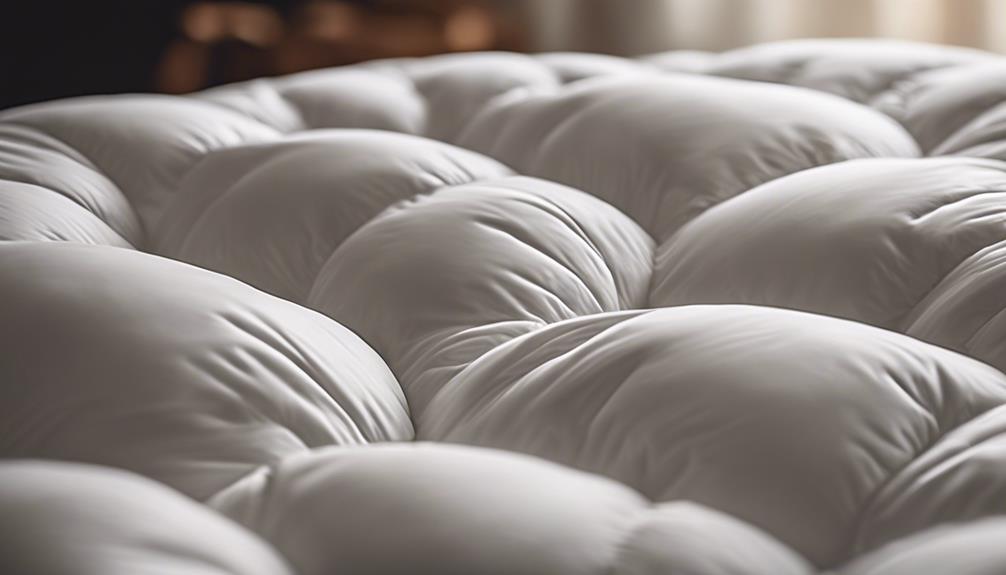
When considering the factors affecting goose down quality, it's essential to look at the down source impact and fill power rating.
The source of the down can influence its quality and sustainability, while the fill power rating indicates the loftiness and insulating capability of the comforter.
Understanding these elements can help in selecting a high-quality goose down comforter for maximum comfort and warmth.
Down Source Impact
The quality and insulation of goose down comforters are greatly influenced by factors such as fill power, density, and cluster size, all of which are impacted by the source of the down, like Hungarian white geese. The source of the goose down plays a significant role in determining the overall quality of the comforter.
Hungarian white goose down is highly sought after for its superior quality. It's known for its large clusters, which provide excellent insulation and fluffiness to the comforter. The source of the down can also affect the durability and warmth of the comforter.
Opting for goose down sourced from reputable places like Hungary ensures that you're receiving premium quality and ethically obtained down for your comforter.
Fill Power Rating
Goose down comforters' quality is closely tied to their fill power rating, a key measure of the loft and insulating capacity of the down within them. Fill power ranges from 300 to 800+ cubic inches per ounce for high-quality goose down comforters. Higher fill power indicates better quality and warmth retention in goose down comforters.
Large cluster goose down in comforters provides superior insulation and comfort in varying temperatures. The fill power of goose down comforters determines their fluffiness, warmth, and overall quality.
When looking for a goose down comforter, paying attention to the fill power can help you choose one that meets your warmth and comfort needs.
Goose Down Comforter Fill Power
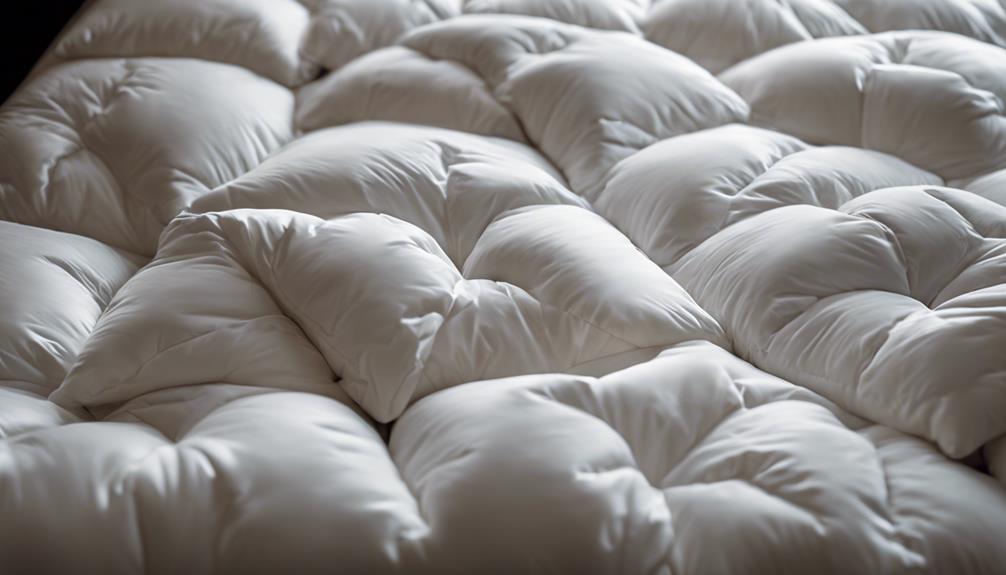
With fill power ranging from 600 to 800+ cubic inches per ounce, high-quality goose down comforters offer exceptional insulation for superior warmth and comfort. Higher fill power indicates better quality and warmth retention, making goose down comforters with a higher fill power level more desirable for those seeking exceptional coziness. Fill power plays a pivotal role in determining the loftiness and fluffiness of a comforter, directly impacting its insulating properties. Understanding fill power is key to selecting the right level of insulation to suit your needs.
| Fill Power Range | Quality Level | Insulation Level |
|---|---|---|
| 600-700 | Good | Moderate |
| 700-800 | Better | High |
| 800+ | Best | Superior |
Goose Down Comforter Insulation Properties
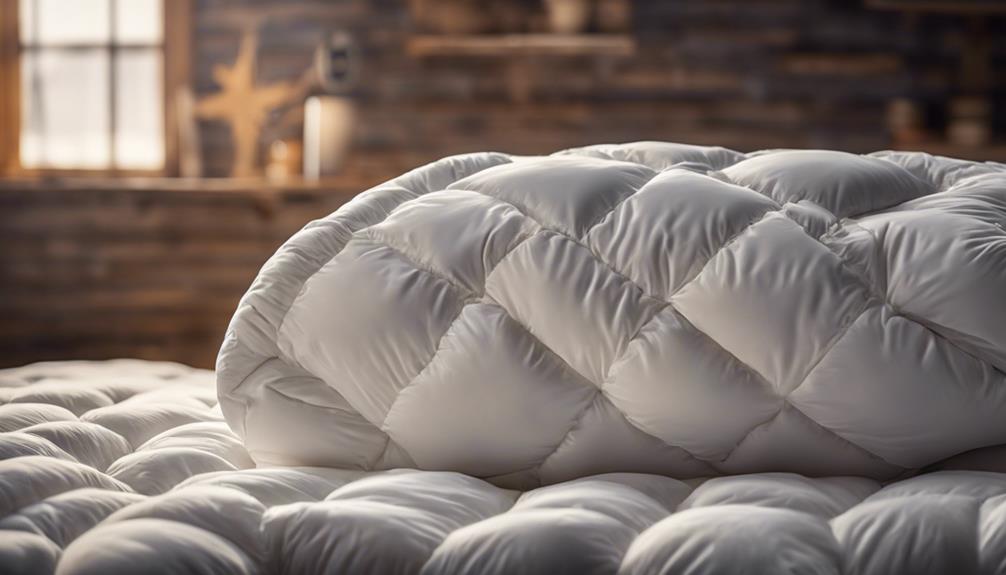
Goose down comforters provide excellent insulation, keeping us warm and cozy during chilly nights.
The natural breathability of down allows for ideal air circulation, preventing overheating and ensuring a comfortable sleep environment.
These properties make goose down comforters a popular choice for those seeking a balance of warmth and breathability in their bedding.
Insulating Warmth of Down
Guaranteeing ideal warmth through efficient insulation, down comforters filled with goose down are prized for their ability to regulate temperature effectively. Goose down comforters boast high fill power, creating tiny air pockets that trap heat for superior warmth. Despite being lightweight, goose down comforters excel in thermal regulation, keeping you cozy in all seasons. The insulating properties of goose down assure long-lasting comfort and quality, making them a popular choice for bedding. Below is a table summarizing the key points about the insulating warmth of goose down comforters:
| Keyword | Description |
|---|---|
| Fill Power | High fill power for superior insulation. |
| Insulating Properties | Traps heat effectively for warmth. |
| Lightweight | Lightweight yet offers excellent thermal regulation. |
| Thermal Regulation | Ensures comfortable sleep in all seasons. |
Natural Breathability Benefits
Utilizing the natural breathability of down clusters, goose down comforters promote a comfortable sleep environment by regulating body temperature effectively. The insulation properties of down clusters create small air pockets that trap body heat while allowing moisture to escape, preventing overheating.
This breathability helps in maintaining a balanced sleep environment by wicking away moisture, ensuring a cozy and undisturbed night's rest. The airflow enhanced by the natural breathability of goose down comforters prevents the build-up of excess heat, offering a comfortable temperature throughout the night.
How to Care for Goose Down Comforters
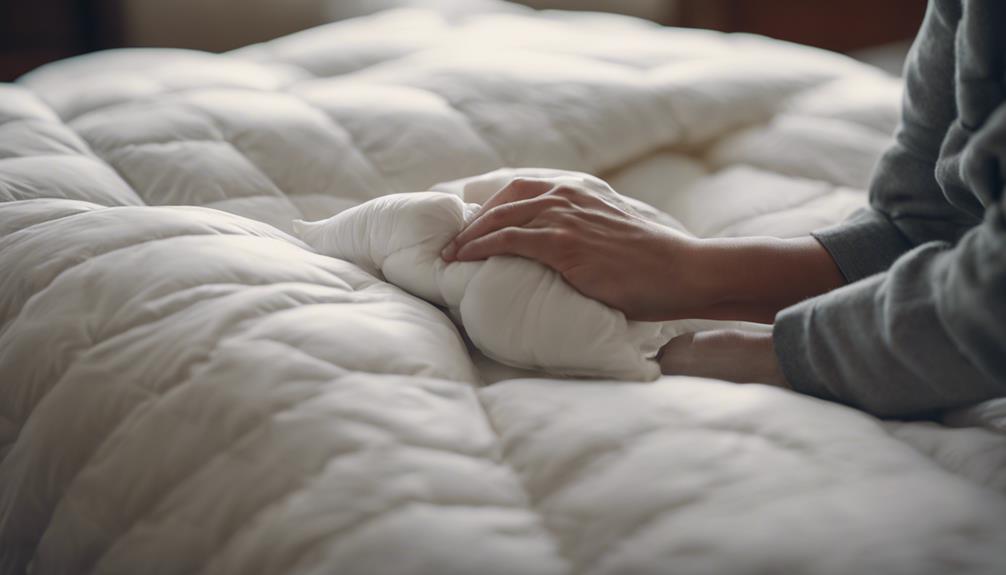
To maintain the loft and insulation of your goose down comforter, it's crucial to regularly fluff and air it out. This helps the down clusters remain fluffy and efficient at trapping heat.
Using a duvet cover can protect your comforter from spills and stains, extending its lifespan. It's best to avoid washing your goose down comforter too frequently as it can strip away natural oils and impact its loftiness.
When it's time for a thorough clean, opt for dry-cleaning or professional laundering to guarantee proper care without damaging the delicate down. For storage, keep your goose down comforter in a breathable bag when not in use to prevent dust accumulation and maintain its quality.
Following these care tips will assist your goose down comforter stay cozy and in top condition for years to come.
Choosing the Right Goose Down Comforter

When selecting a goose down comforter, it's vital to take into account factors such as fill power and the type of down used to guarantee peak warmth and quality. Hungarian white goose down is renowned for its luxurious comfort and superior insulation, making it a premium choice for those seeking high-quality comfort. To make sure you choose the right goose down comforter for your needs, consider the fill power, which indicates the fluffiness and warmth of the comforter.
| Factors to Consider | Description |
|---|---|
| Fill Power | Determines fluffiness & warmth |
| Type of Down | Hungarian white goose for quality |
| Comfort | Lightweight yet provides exceptional warmth |
| Quality | Long-lasting comfort & durability |
Frequently Asked Questions
Is Goose Down Better Than Down Comforter?
Yes, goose down is better than regular down filling for comforters.
Goose down offers superior warmth, softness, and durability due to its larger clusters that provide better loft and enhanced insulation.
Choosing a goose down comforter guarantees luxurious comfort, longevity, and a cozy sleeping experience.
What Are the Benefits of a Goose Down Comforter?
We love the benefits of a goose down comforter! It offers superior warmth and luxurious softness for a cozy night's sleep.
The fine feathers beneath geese exterior feathers provide exceptional quality and insulation. With high fill power, these comforters are fluffy and durable, ensuring long-lasting comfort.
They're breathable, resilient, and known for their ability to keep you warm throughout the night. A goose down comforter is a fantastic investment for a restful sleep experience.
Which Is Warmer, Duck Down or Goose Down?
Goose down is generally warmer than duck down due to its larger cluster size and higher fill power. The larger down clusters in goose down create more air pockets, providing better insulation and warmth.
Goose down comforters offer superior warmth retention and are preferred in colder climates. When it comes to warmth, goose down is often the preferred choice for its excellent insulating properties.
Are Ducks and Geese Killed for Down Comforters?
We're happy to share that geese aren't killed solely for their down used in comforters. Down is gathered during the natural molting process of geese, ensuring no harm comes to them. Responsible suppliers follow ethical standards to protect the geese.
The down industry promotes sustainability by using a by-product that would otherwise go to waste. Certification guarantees humane treatment of geese during the down collection process.
Can a Goose Down Comforter Be Replenished with Lost Feathers?
Yes, a goose down comforter can be replenished with lost feathers. Over time, down comforter feather loss is unavoidable as feathers can wear out or fall out. However, you can purchase additional down or feathers to refill and fluff up your comforter, extending its lifespan.
Conclusion
To sum up, a goose down comforter is like a warm hug from a friendly bird. Its fluffy feathers provide excellent insulation, keeping you cozy and comfortable all night long.
With proper care, a goose down comforter can last for many years, making it a worthwhile investment for a good night's sleep. Choose the right one based on fill power and insulation properties to guarantee maximum comfort and quality.
Rest easy knowing you have the perfect bedding companion.
